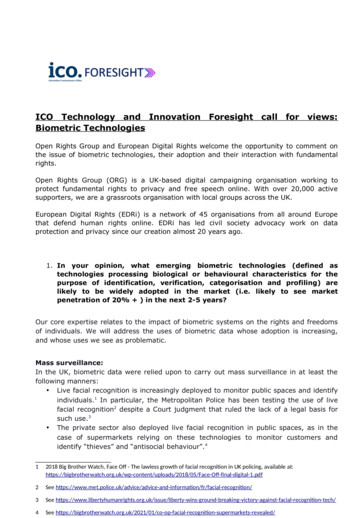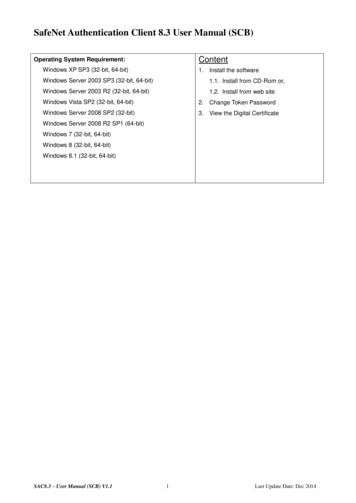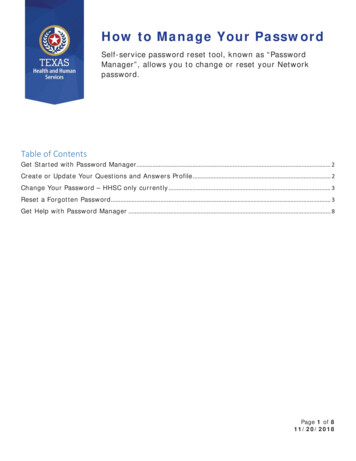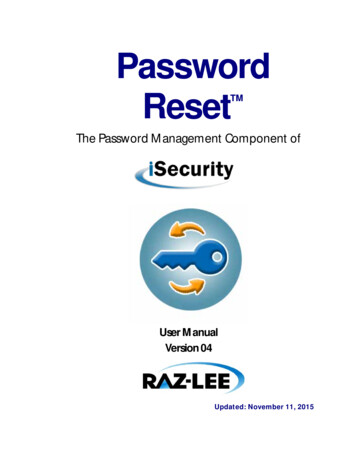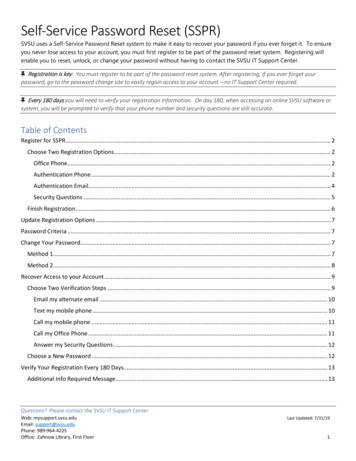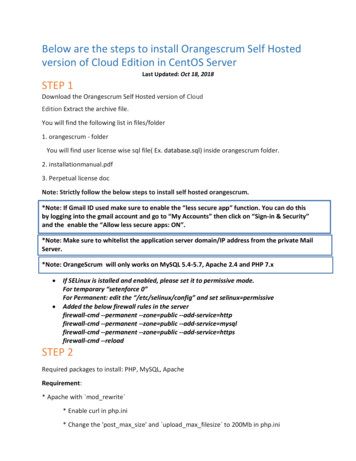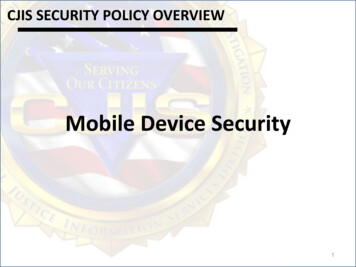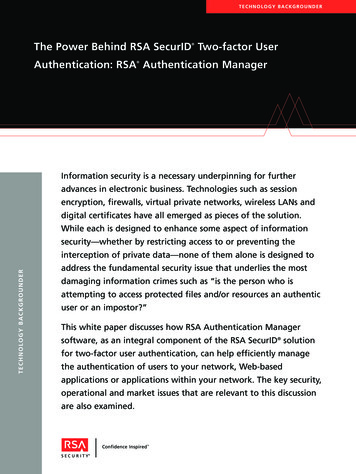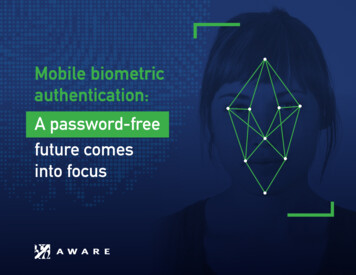
Transcription
Mobile biometricauthentication:A password-freefuture comesinto focus
Table of ContentsIntroductionFacial RecognitionLiveness Detection and Multimodal BiometricsFIDO: Standards-Based, Password-Free AuthenticationBiometric Authentication with ChatbotsOut-of-Band BiometricsContinuous AuthenticationThe Ultimate Objective:Invisible Authentication
IntroductionIf you looked into your Magic 8-Ball and asked, “Will I ever be able to stopusing passwords for authentication?” it would certainly reply:And the outlook is good considering biometrics are making authenticationsimpler and more secure than ever. Passwords have never looked so retro.But if you asked us the same question, we would say you don’t need a Magic8-Ball to know that the future of authentication is already here.Expect to see the following authentication advancements in action soonerthan later.
Facial RecognitionWhen rumors were first heard that Apple’s iPhone X would not have afingerprint sensor, aspiring fraudsters could be forgiven for a moment ofencouragement. Alas, that hope was short-lived, as we now know that facialrecognition is used in its place.“Magic 8-Ball, does this mean that facial biometrics arehere to stay for mobile authentication?”Apple Face ID is here. The trendsetting device maker has opted for 3-D facialrecognition technology in place of fingerprints for the newest iPhone.Facial recognition for authentication has existed for several years. However,Apple’s seal of approval further confirms not only its ease-of-use, but also thepowerful security features of the underlying biometric technology that makeit possible. As with fingerprints before it, Apple promises to usher in broadmarket adoption of facial recognition for mobile authentication.
Liveness Detection and Multimodal BiometricsWhy stop at face recognition? Fraudsters will undoubtedly try to spoofbiometric authentication security measures.Fortunately, modern biometrics are equipped with technologies that assessthe “liveness” of the user. They make it difficult for a fraudster to use a video oraudio recording of a victim to impersonate them.A multimodal approach applies different biometric modalities such as face,voice, and keystroke dynamics to increase security. The additional biometricdata not only improves biometric performance in terms of fewer false matchesand non-matches. It also contributes to liveness detection.Face voice keystroke Multimodal biometric authentication.Facial recognition can be added to other modalities for improved performanceand liveness detection. For example, a user can type in a passphrase whilelooking into the camera. The authentication engine simultaneously analyzeskeying cadence and facial geometry, making it more biometrically accurateas well as more difficult to spoof. Or, the app may request a random spokenseries of numbers while capturing the facial image. The two can be matchedand analyzed for liveness in concert. The chances of spoofing that, accordingto the Magic 8-Ball, are.
FIDO: Standards-Based,Password-Free AuthenticationEven though they were invented back in the 1960s, passwords are still themost commonly used authentication mechanism. With the vastness of today’sinternet and the power of our smartphones, passwords have become intolerablyinconvenient and vulnerable to compromise through phishing, breaches ofpassword storage servers, brute-force guessing, and social engineering.FIDO aims to get rid of the password and enhance authentication ina standards-based way, using biometrics and public key (asymmetric)cryptography. Under FIDO, a unique private/public key pair is created on adevice, such as by a mobile banking app. Importantly, the biometrics andprivate keys never leave the mobile device; only the public key is storedcentrally. Upon authentication, a successful biometric match makes the localprivate key available for a challenge response to the server.FIDO 2.0 standards are being adopted to build authentication right into thebrowser, effectively filling the missing identity layer of the internet. Imagineauthenticating a transaction through a bank’s website using a combinationof facial recognition and keystroke analysis without needing to memorizecomplex passwords. It would be easier for customers to bank online securelyand harder for fraudsters to exploit stolen account data.Does this approach make a large scale theft of passwordsvirtually impossible?
Biometric Authentication with ChatbotsA chatbot is a computer program that can communicate in written form ina way that simulates human conversation. Thanks to rapid advancementsin machine learning, they’re harder than ever to distinguish from humans,prompting many organizations to use them for certain types of customerinteraction. They can be extremely useful and easy to work with, but can theybe used for applications where security is needed, as in “Bankbot, can youplease pay my electric bill on Thursday?”Authenticating during a text chat, such as by using keystroke dynamics andeven face biometrics, can make bot-chatting useful for applications wheresecurity is required. Soon, they’ll be able to not only understand what you’resaying but also to verify that you are who you claim to be.Chatbots with built-in, continuous security?
Out-of-Band BiometricsAn “out-of-band” approach to authentication involves using multiple channelsto ensure that a transaction originates with the user. For example, using amobile device to log in to a website through a browser on a PC. In this way,a mobile device can serve as an additional authentication factor like a token,representing possession (something a user has) to demonstrate authenticity.But what if the device is compromised? The possession factor is largelyrendered useless and actually becomes a liability. By adding biometrics asan authentication factor, possession is enhanced with inherence (somethingthe user is). This time, when logging into a website via browser, the userstill receives an out-of-band authentication challenge, but it will include arequirement to perform a biometric authentication on the device, making itmuch harder for a lost or stolen device to be used to fraudulently access theowner’s online accounts.Our prediction for out-of-band mobile biometric authentication?
Continuous AuthenticationPeople tend to think of authentication as a gateway; complete your biometriccapture or enter your password and “Open Sesame.”However, biometric modalities such as keystroke dynamics and facialrecognition analysis have introduced the possibility of continuousauthentication. This always-on, real-time method is more process than event.For example, while typing information into a website, keying cadence can beanalyzed in real time to detect anomalies that indicate a fraudulent user. Ifthere is a deviation that indicates a change in identity, your session may beterminated. Other biometric modalities such as face and voice could also beused in this way to ensure the security of a session or phone call.Continuous authentication is definitely in its infancy, but according to MarkDiodati, research vice president at Gartner, adoption is “inevitable.”In Magic 8-Ball speak, that’s as good as a:
The Ultimate Objective: Invisible AuthenticationSecurity measures are a means to an end, and authentication is no exception.We’d prefer it to be in the background, even completely invisible.In fact, invisibility is the ultimate objective of authentication, and it’s nearer toreality than ever before. As biometric modalities like face, voice, and keystrokerapidly advance, identity verification will come closer to happening without anyactive participation from the user, while improving resistance to fraud at thesame time. Authentication has always strived for security with convenience.Invisible biometric authentication makes it a reality.Is there finally an end in sight for the 50-year-old password? Can biometricsdeliver on the ultimate objective of invisible authentication?This time, we don’t need a Magic 8-Ball to know that the answer to both isa resounding, “Yes.”
People tend to think of authentication as a gateway; complete your biometric capture or enter your password and "Open Sesame." However, biometric modalities such as keystroke dynamics and facial recognition analysis have introduced the possibility of continuous authentication. This always-on, real-time method is more process than event.
